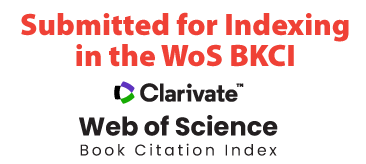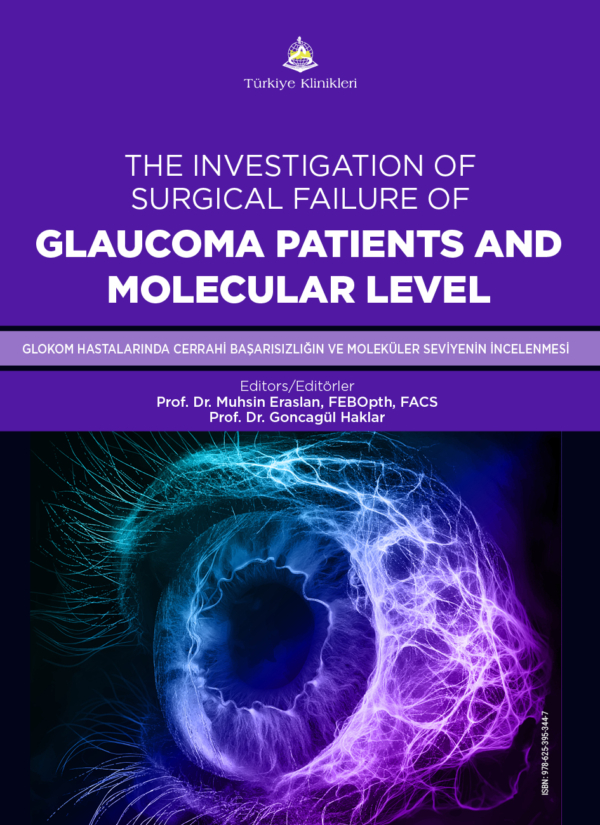The ‘minimally invasive glaucoma surgery’ (MIGS) procedure, which was developed in 2012, aimed to control intraocular pressure and reduce the need for glaucomatous medication with less risk and postoperative follow-up. Many Ab externo and Ab interno procedures have been applied in the development of MIGS. In addition, these methods have been applied by widening the Schlemm canal, increasing suprachoroidal outflow, or providing subconjunctival filtration.
This book is one of the pioneering studies investigating conjunctival fibrosis at the molecular level, which affects the success of MIGS, is one of the most popular glaucoma surgeries of recent years, and the most commonly performed gel mi- croimplant surgery. In this context, although there are a few studies investigating the effects of Monocyte Chemoattractant Protein-1 (MCP-1), Cysteine-rich and Acidic Secreted Protein (SPARC) and Thrombospondin-2 (TSB-2), which have important roles in the fibrosis mechanism, on conjunctival fibrosis in the classical filtrant surgery procedure with experimental animal models, clinical studies are very few.
The pathophysiological mechanisms activated by tissue healing caused by in- jury are the same in tissues other than nervous tissue. Following tissue injury, dynamic changes occur in epithelial and mesenchymal cells and wound healing tissue. Therefore, the inflammatory environment triggers proliferation and cell migration, causing phenotypic changes that lead to tissue restructuring. In this respect, the main chemokine that regulates the migration and infiltration of mac- rophages and neutrophils is MCP-1. Characteristic of the remodeling process is granulation tissue accompanied by inflammatory cell influx, neovascularization, and altered vascular permeability. SPARC and thrombospondins, which are mem- bers of the matricellular protein family, play a role in the regulation of the extra- cellular matrix (ECM) and the change of its structure. In this book, the primary purpose is to investigate MCP-1, SPARC and TSB-2 proteins, which is thought to cause subconjunctival fibrosis formation, surgical failure and the need for bleb needling, in POAG patients receiving glaucoma gel microimplants. In addition, the other aim of the study is to investigate the relationship between markers indi- cating the progression of POAG and these molecules. As a result of the findings and statistical data, the result will be discussed and then the conclusion will be presented. This book will also contribute greatly to the literature of ophthalmol- ogy and medical biochemistry as well as providing molecular guidance for the management and success of MIGS.
First of all, as editors of this book we would like to send my thanks to Dr. Ceren Turkoglu as an author, she provided her precious knowledge and support during the preparation of the book. We would also like to express my endless gratitude to Dr. Necmettin KÜRTÜL, who is Head of the Foreign Languages and Translation, for the precious help and support during the language editing process.
Prof. Dr. Muhsin Eraslan, FEBOpth, FACS
Prof. Dr. Goncagül Haklar
Özet
Glaucoma, which is one of the most common causes of permanent blind- ness worldwide and has a prevalence of 1-4%, is a neurodegenerative disease characterized by damage to retinal ganglion cells and axons, progressive optic neuropathy, and associated visual field loss. Primary open angle glaucoma is the most common type of glaucoma, which accounts for almost half of all glaucoma cases.
Intraocular pressure is the most important risk factor for the development of glaucomatous optic neuropathy. Also, lowering the intraocular pressure value is still the only treatment approach proven to be effective in preserving visual function. Generally, the first step in treatment is medical, but it may not be sufficient. By bridging the gap between conservative treatment (drugs and laser treatments) and invasive traditional glaucoma surgeries, Microinvasive Glaucoma Surgeries mark an important milestone in the field of glaucoma management. New surgical interventions have been considered to reduce the complications encountered in trabeculectomy, which is considered the gold standard surgical method of primary open angle glaucoma. Glaucoma gel mi- croimplant (The XEN® Gel Stent Allergan INC, Dublin, Ireland), one of the Microinvasive Glaucoma Surgeries methods, creates an outflow path similar to trabeculectomy with an internal procedure. In this way, with the internal route, conjunctival incision is avoided, and it also allows the surgical process to be completed in a shorter time.
This book is one of the pioneering studies investigating conjunctival fibro- sis at the molecular level, which affects the success of Microinvasive Glau- coma Surgeries, one of the most popular glaucoma surgeries of recent years, and the most commonly performed gel microimplant surgery. The primary purpose of the book is to investigate MCP-1, SPARC and TSB-2 proteins, which is thought to cause subconjunctival fibrosis formation, surgical failure and the need for bleb needling, in primary open angle glaucoma patients re- ceiving glaucoma gel microimplants. In addition, the other aim of the book is to investigate the relationship between markers indicating the progression of primary open angle glaucoma and these molecules.
While phacoemulsification surgery was conducted on 20 patients out of 36 patients diagnosed with primary open-angle glaucoma (Group 1); 16 patients underwent glaucoma gel microimplant and phacoemulsification combined
surgery (Group 2). While bleb needling should be applied to five patients in Group 2a; it was not applied to 11 patients (Group 2b). Samples taken from the limbal paracentesis region were analysed by Enzyme-linked immunoas- say method for a total of three molecules. The patients were between 46 to 80 years old, 9 of whom (25%) were female and 27 were male (75%). The mean age of the patients in Group 1 was 68.50 ± 8.88 years, whereas those in Group 2 were 62.12 ± 7.26 years in Group 2. There were no intraoperative complications in the patients included in this study. Postoperative complica- tions occurred 31.25% in Group 2 and were resolved with medication. On the other hand, at the end of six months, the partial success rate was 93.3% (>20% reduction in IOP with and without antiglaucomatous medication), and the complete success rate was 60% (>20% reduction in IOP without medica- tion). Also, the need for bleb needling occurred in 37.5% of the patients to who underwent combined surgery. The IOP values of the patients in Group 2a on postoperative day-1 and in week-1 were significantly higher than those in Group 2b (p < 0.05). In this case, it can be said that IOP values in postop- erative week-1 are guiding in predicting the need for bleb needling. Also, the average bleb needling time was 3.60±1.95 months.
In conclusion, all three molecules (MCP-1, SPARC and TSB-2) were found to be highly associated with the number of antiglaucomatous molecules used preoperatively, and these three molecules were found to be relevant in chronic inflammation. Therefore, it has been taken into consideration that es- pecially SPARC and TSB-2 matricellular proteins may be effective on chronic inflammation, glaucomatous progression and fibrosis, but these effects may be caused by many factors. It is predicted that the surgical procedure followed creates minimal trauma to the tissue, so it does not trigger high levels of in- flammation. Additionally, considering the Computerised Visual Field Tests Mean Deviation value, which is a guiding finding in terms of the progres- sion of primary open angle glaucoma, it was observed that the values seen in Group 2a patients were more advanced. Therefore, the result obtained makes an extremely important contribution to the literature. In the book, it was de- termined that among the patients to whom we applied glaucoma gel microim- plant, those in advanced stages and those who used more antiglaucomatous molecules were more likely to have fibrosis and need bleb needling. Bölümler
CHAPTER 1
Introduction
Ceren Türkoğlu
CHAPTER 2
Anatomy
Ceren Türkoğlu
CHAPTER 3
Physiology
Ceren Türkoğlu
CHAPTER 4
The Evaluation of Glaucoma and Pathogenesis of Glaucoma Damage
Ceren Türkoğlu
CHAPTER 5
Classification of Glaucoma
Ceren Türkoğlu
CHAPTER 6
Glaucoma Treatment
Muhsin Eraslan, Ceren Türkoğlu
CHAPTER 7
Microinvasive Glaucoma Surgery
Muhsin Eraslan
CHAPTER 8
Cataract and Phacoemulsification
Ceren Türkoğlu
CHAPTER 9
Materials and Methods
Ceren Türkoğlu, Goncagül Haklar
CHAPTER 10
Findings
Ceren Türkoğlu, Goncagül Haklar
CHAPTER 11
Discussion
Ceren Türkoğlu
CHAPTER 12
Conclusion, Recomendation and Limitations
Ceren Türkoğlu
REFERENCES



